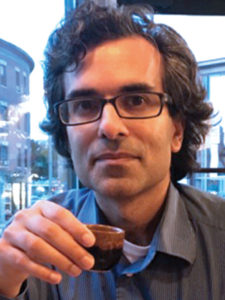
The Accelerating Medicines Partnership (AMP) is beginning to see early data from its network of investigators working in rheumatology. Some of that early data will be shared at an ACR Basic Science track session from 4:30 – 6:00 pm Tuesday.
AMP: Cells in Target Tissue Using Single-Cell Technological Advancesin Room W375a will provide molecular insights into the pathological basis of rheumatoid arthritis and lupus nephritis that may better stratify patients, identify biomarkers for prognosis and treatment response, and reveal new pathways and targets for drug development. AMP, a public-private collaboration, works to increase the number of new diagnostic tools and therapies for patients while reducing the time and cost of developing them.
One of the presenters, Soumya Raychaudhuri, MD, PhD, Professor of Medicine at Harvard Medical School, Boston, MA, and a Visiting Professor in Genetics at the University of Manchester, England, said the session would highlight research that seeks to understand what’s going on at the cellular level when patients have a rheumatic disease such as lupus or rheumatoid arthritis. In his presentation, he will specifically explore “Novel Populations of Immune Cells in the RA Synovium.”
“In the past few years, single-cell technologies have really taken off,” he said. “In the past, we could really only apply a handful of markers to identify the cells — a dozen or less. Recent technologies such as single-cell RNA sequencing have allowed us to get thousands of gene measurements on each cell. This really takes what we are able to learn about what’s going on in the tissue — especially during inflammation — to a new level.”
Dr. Raychaudhuri will discuss how this single-cell technology is allowing for new research of the synovial tissue and improving the understanding of what is happening in the synovium when a patient has an active disease.
“When the synovium is inflamed, as it is in rheumatoid arthritis, what’s going on at the cellular level?” he asked. “What are the key players in that inflamed tissue? Which cell populations are disproportionately represented? And which populations of cells do we imagine are likely to be pathogenic?”
Dr. Raychaudhuri said data show there are key populations — both traditional immune populations as well as stromal fibroblast populations — that are expanded in rheumatoid arthritis in the synovium.
“Some of those key populations are responsible for producing some of the cytokines — IL-6, for example,” he said. “We can see it’s being produced by a specific subset of fibroblasts and a specific subset of B cells. So not only are we able to see some of the key populations, we’re also able to see where the effector molecules that are propagating inflammation are coming from.”

During her presentation, Betty Diamond, MD, Professor and Head of the Center for Autoimmune, Musculoskeletal and Hematopoietic Diseases at the Feinstein Institute for Medical Research, Manhasset, NY, will show the feasibility of a single-cell transcriptomic approach to understanding lupus nephritis.
“The Landscape of Immune Cells in the Lupus Nephritis Kidney” will review the data that have been generated so far identifying both tissue resident cells and infiltrating blood borne cells in the kidneys of patients with lupus nephritis.
“The overall goal is to find new therapeutic targets and new ways to stratify patients that may be informative with respect to best treatment options or prognosis,” Dr. Diamond said.
In her research, Dr. Diamond and her colleagues have identified a population of ABCs—autoimmunity or age-associated B cells—that are present in lupus kidneys. These have been linked to autoantibody production and are present in many diseases characterized by chronic inflammation. They have also identified a population of T peripheral helper cells in kidneys. This is a population that is related to — but not identical to — T follicular helper cells that might be involved in in situ B cell activation in the kidney.
“We have identified macrophages in the kidneys with pro-inflammatory properties and with tissue repair properties, and we are interested in whether this transition from one to the other can occur,” she said. “There’s evidence of increased expression of interferon-induced genes in many different cell types of the kidney.
“Generally, I think we’re rethinking lupus nephritis. In part, because of studies showing you can have a complete renal response defined clinically but still have active inflammation ongoing in the kidney.”

Jill P. Buyon, MD, Professor of Medicine and Division Director of Rheumatology at NYU Langone Health, New York, NY, will present “Characterization of Renal Resident Cells in Lupus Nephritis.” Like Dr. Diamond, Dr. Buyon is looking closely at single cells in the kidney.
With less focus on the traditional immune cells, Dr. Buyon’s group is specifically concentrating on the resident renal cells themselves and how they are involved in the process of kidney injury. Moreover, her group is addressing whether the transcriptome of cells from other tissue beds, such as the skin, reflect the pathologic processes occurring in the kidneys.
“Is what is happening in the kidney a result of factors in the circulation?” she asked. “Might there be other tissue beds that could also be affected as well? Could we find a tissue bed that’s more accessible than the kidney?”
To address these questions, Dr. Buyon will present data on the resident cells of the kidney as well as unaffected skin obtained from the same patients.
“We’re going to show data that both skin and kidney cells express type-I interferon response signatures and that these signatures associate with poorer responses to therapy,” she said. “Moreover, we have found that poor responders have a more fibrotic signature in the kidney cells.”
Dr. Buyon said this type of work may shed light on the different types of kidney involvement, including membranous or proliferative.
Her hope is that this type of research supported by AMP someday may eliminate or at least decrease the frequency of more invasive kidney biopsies.
“If you have to biopsy the kidney, it’s obviously a procedure,” Dr. Buyon said. “The beauty of what we’re going to show during this session is the kind of science we can do with help from initiatives like AMP. This is all very early data, but this is what the AMP program has the potential to do.”
